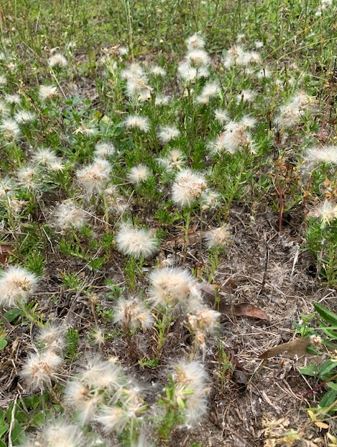Do you have a low-growing weed that is producing tufts of white, fluffy, dandelion-like seeds, which float in the wind when disturbed or mowed? This is Annual Trampweed (Facelis retusa). I did not see this weed in North Florida until recent years. It’s native to South America.
Mid-April to early May is the time of year when this winter annual weed goes to seed in North Florida. That’s what it is doing now and it is a prolific seed producer. Each white tuft contains numerous seeds. Each tiny seed is attached to a small individual bristle, coming out of the larger tuft, which is carried by wind. This allows hundreds of seeds to move to other locations.
Trampweed is approaching the end of its life as we move into early May. As a winter annual, the individual weed dies in response to warm temperatures only to leave behind hundreds of seeds that survive the summer. These same seeds come up the following fall to early winter to begin the next generation. The best time to attempt chemical control with an herbicide is well before these weeds mature and begin flowering.

One chemical control option is to apply a lawn preemergence herbicide during October when nighttime temperatures drop to 55° to 60°F for several consecutive nights. This will be just before these winter annual weeds emerge. Done correctly, the application of a preemergence herbicide forms a temporary chemical barrier along the soil surface preventing the winter annual weeds from emerging. Hence the name preemergence.
A second application of preemergence herbicide may be required six to nine weeks after the initial application to achieve season-long control, based on the product’s label directions.
If you miss this narrow window of opportunity to apply a preemergence herbicide, watch for the small young weeds in winter and treat then with a postemergence herbicide that is labelled for use in the type of lawn grass you are growing.
Waiting until trampweed is producing flowers and seeds in April and May to attempt control is almost worthless in controlling this weed. Correct timing is critical.
Trampweed usually is found in areas of a lawn that are already weak and thinning. It favors open, dry, stressed and low-fertility areas of a lawn. So, try to manage your lawn correctly. This involves learning to mow, irrigate and fertilize correctly for the type of lawn grass you are growing.
More information on Florida lawns is available at https://hort.ifas.ufl.edu/yourfloridalawn or from the UF/IFAS Extension Office in your County.
- Nuisance Gnats abound in Northwest Florida this spring - June 26, 2025
- Watering to Establish a New Lawn - May 15, 2025
- Sweet Onion and Strawberry Success, a Matter of Variety and Timing - April 10, 2025
